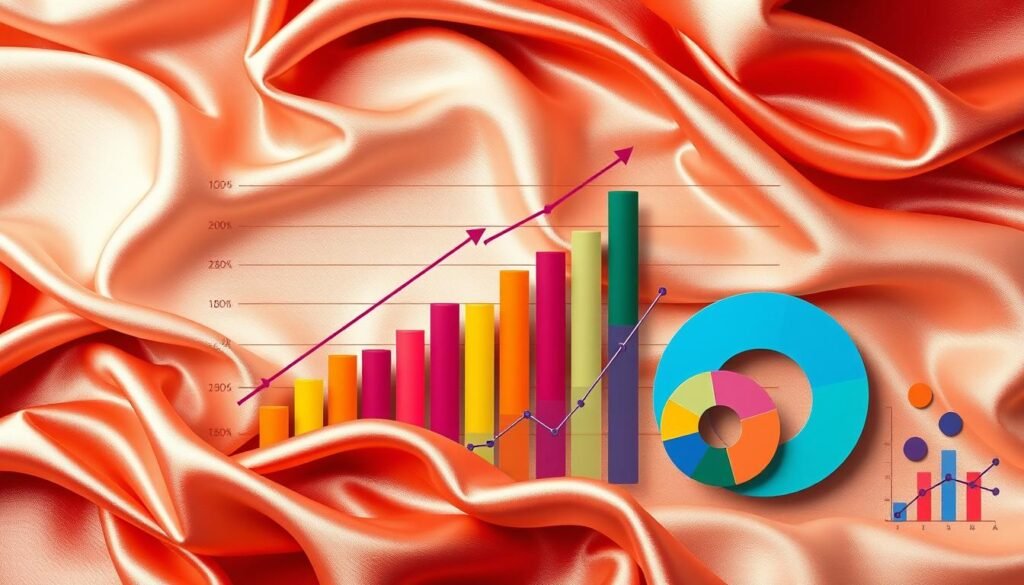“The greatest danger in times of turbulence is not the turbulence—it is to act with yesterday’s logic.” – Peter Drucker
The silk industry is booming again. It’s becoming a key player globally. Silk sales could hit USD 771.62 million soon. This analysis discusses its growth, trends, and hurdles. It highlights an 8.30% growth rate. This shows a rising demand in fields like textiles, cosmetics, and medicine. Today’s silk market is full of chances and solutions. This includes fighting issues in sourcing and material costs. We will look more into global silk trends and their impact.
Key Takeaways
- The global silk market is expected to reach USD 16,387.16 million by 2027.
- Major stakeholders like Anhui Silk and Eastern Silk Industries are driving innovation.
- The demand for silk spans textiles, cosmetics, and medicinal applications.
- Technological advancements are crucial for addressing market challenges.
- High material costs continue to pose a significant challenge for manufacturers.
- Asia-Pacific remains the dominant region in silk production and consumption.
Overview of the Global Silk Market
The global silk market was worth about USD 15.6 billion in 2021. It’s expected to hit USD 34.1 billion by 2031. The growth rate yearly is 8.2% between 2022 and 2031. Silk’s demand comes from its luxury feel, lightweight, and strong quality. These features make it popular in fashion and textiles.
China and India are top silk producers worldwide. Mulberry silk is the highest quality and most produced type. Spider silk is new and offers unique uses.
Textiles are the main use for silk, in clothes and home items. Silk is also getting popular in cosmetics and medical fields, like for stitches. This opens more growth paths.
The Asia-Pacific area is the leading silk producer, expected to grow the fastest. Silk-making is labor-heavy but new tech is making it better and high quality.
Companies like Anhui Silk Co. Ltd. and Kraig Biocraft Laboratories, Inc. are key market players. The market relies a lot on China for raw silk, raising issues with work intensity and cost. Despite challenges, the silk industry’s growth looks promising. Keeping an eye on market value and production is important for those involved.
Market Growth Trends
The silk market is growing fast. This is because people now prefer eco-friendly products. In 2023, the market was worth about USD 124.2 billion. From 2024 to 2030, it’s expected to grow by 8.0% each year. This shows people want sustainable silk more and more.
Several factors make the silk market boom. New sericulture technology is one, making silk more sustainable. Also, the middle-class in emerging markets is buying more. This creates a good space for the silk industry to grow. The fashion industry, in particular, is buying lots of luxury silk products in 2023.
In 2023, most silk textiles were sold through retail stores. Asia Pacific leads the market, thanks to China and India’s rich silk traditions. Big names in the market include Jiangsu Sutong Cocoon and Silk Co. Ltd., among others. They are working with partners like Japan’s Gunze to focus on eco-friendly silk.
In the silk world, different types stand out. Mulberry silk is the most popular. But Tussar silk is also important for its special look. Eri silk, known as ‘peace silk’, is becoming more popular. It’s all because the silk sector is turning towards sustainable choices. This will shape its future.
| Year | Market Size (USD Billion) | Growth Rate (%) |
|---|---|---|
| 2023 | 124.2 | – |
| 2024 | – | 8.0 |
| 2032 | 34.1 | 6.9 |
Segment Analysis of Silk Products
The silk market is divided into different types. These include Mulberry Silk, Tussar Silk, and Eri Silk. Each kind has its own special features and uses. This affects how much they are wanted in various fields. For example, Mulberry Silk is known for being top-notch and safe for people with allergies. It’s perfect for fancy clothes and beauty items.
Textiles take up a big part of the silk market, with a 65% share in 2022. This area covers things like dressy clothes, decorations for homes, and personal items. The textile section is expected to grow a lot. This is because people have more money to spend and fashion keeps changing.
End-user analysis shows that cosmetics and medical fields really want silk. Silk’s good points, like getting along well with the human body, make it great for medical threads and beauty goods. As the market changes, people want silk that is made right. They prefer things that are kind to the earth and don’t harm the environment.
| Type of Silk | Market Share (2022) | Projected Growth Rate (2023-2032) |
|---|---|---|
| Mulberry Silk | Approx. 60% | 8.5% |
| Tussar Silk | Approx. 25% | 7.0% |
| Eri Silk | Approx. 15% | 6.5% |
This analysis shows important facts about silk market trends. It points out where there are chances to grow in silk product types and their uses.
Silk Product Sales Analysis
The silk market is growing fast, showing us its potential. Experts predict a strong growth path due to higher demand in different fields. For textiles, cosmetics, and medical uses, silk is becoming more popular. This growth comes from people learning about silk’s good points and better ways to make it.
Market Size and Forecast
From 2024 to 2031, experts see the silk market booming, with a notable Compound Annual Growth Rate (CAGR). Different silk types like Mulberry, Tussar, and Eri silk are making it more popular. The report covers market size, competitors, how much we can make, and what’s needed and available.
Growth Rate and Key Drivers
The growth of the silk market is driven by some main factors. Its use in clothes and the textile industry as a skin-friendly material is boosting its growth. Especially in North America and the United States, these places are key to this boost. The report predicts a strong future for silk, with global trends raising demand.

| Year | Market Size (in Billion USD) | CAGR (%) |
|---|---|---|
| 2024 | 10.5 | 8.2 |
| 2025 | 11.2 | 8.5 |
| 2026 | 12.1 | 8.7 |
| 2027 | 13.0 | 9.0 |
| 2028 | 14.0 | 9.3 |
| 2029 | 15.1 | 9.5 |
| 2030 | 16.3 | 9.8 |
| 2031 | 17.6 | 10.0 |
Key Players in the Silk Industry
The silk industry is driven by many important players. They play a big part in shaping the market. These top manufacturers are crucial for making top-quality silk goods. They also help in pushing for new ideas and growth in the field.
Leading Silk Manufacturers
Top names include Anhui Silk Co. Ltd. and Eastern Silk Industries Ltd. Kraig Biocraft Laboratories, Inc. is another leader. These companies are known for their quality and reliability. They help increase the silk market’s value significantly. This value is expected to grow a lot from 2024 to 2034.
They predict a 5.8% growth each year during this time. This means the demand for silk will go up. This highlights the importance of these leading manufacturers.
Strategic Collaborations and Innovations
Partnerships are key for silk makers to improve and innovate. Jiangsu Sutong Cocoon and Gunze have teamed up for sustainable silk. These partnerships help bring new products. They also improve research in silk. By working together, companies can face challenges better.
This helps them stay strong in a tough market. For tips on picking reliable manufacturers, check the guide here.
Regional Analysis of Silk Demand
The silk market’s regional traits show how areas differ in making and liking silk. Asia-Pacific leads this scene, with China and India at its heart. They shape the silk market greatly.
Dominance of Asia-Pacific
Asia-Pacific rules the silk world with almost all market share. China’s part is 53%, India follows with 46%. Their production and cultural love for silk make them top players. This keeps the Asia-Pacific silk market growing.
Rising Trends in North America
North America’s silk interest is climbing, thanks to eco-friendly silk goods. Luxury textiles are more wanted. And online shopping is changing silk buying ways. This shows North Americans prefer greener silk, affecting its production and sale.
Silk demand changes as companies adjust. Jiangsu Xinyuan Silk and Guangxi Jialian Silk become more important. They help meet new market needs. Learn more at Tianruiyi’s about us page.
Applications of Silk Products
Silk is used in many areas, from fancy clothes to beauty and health products. Its special features, especially in mulberry silk, make it popular in different fields.
Textiles and Fashion
In silk textiles, silk means luxury. It’s used in fancy dresses, shirts, and ties. Silk’s popularity helps make the fashion sector more profitable. Most silk comes from the Asia-Pacific area.
Brands like Tianruiyi make custom silk pajamas. These pajamas focus on comfort and style. Find out about custom silk pajamas and the choices you have.
Cosmetics and Medical Applications
Silk is also big in the cosmetics world. It’s in many skincare products because of silk fibroin. In medicine, it’s used for stitches and covering wounds. Silk is good for this because it doesn’t bother skin and fights germs. This shows how silk can improve health and looks.
| Application | Uses | Key Benefits |
|---|---|---|
| Textiles | Apparel, Home Decor, Footwear | Luxurious feel, Strength, Lightweight |
| Cosmetics | Skincare products, Hair care | Moisturizing, Hypoallergenic, Antimicrobial |
| Medical | Sutures, Wound dressings | Biocompatibility, Antibacterial properties |
The silk market is growing fast, and it’s expected to keep getting bigger. People want things that are both eco-friendly and fancy. That’s why silk is becoming more popular in many areas.
Consumer Trends in Silk Products
More people now want silk that’s good for the earth. They shop online for its benefits. Brands are making silk in ways that don’t harm the planet. This is to keep their customers happy.
Shift Towards Sustainable Fabrics
The silk business is getting greener. People like products that are made fairly and cleanly. Brands that use eco-friendly methods are more popular. Tianruiyi Textile Co., Ltd. is known for its quality silk that respects the environment.
Impact of E-commerce on Silk Sales
The pandemic made online silk shopping very popular. Websites offer many silk options easily. This change helps brands reach more people. Companies doing well online sell more silk luxury items.
Challenges Facing the Silk Market
The silk market is facing big challenges that hit both those who make it and sell it. There are big swings in the costs of raw materials. Plus, moving goods around can get really tough. It’s super important to understand these issues. That way, strategies to improve and keep making money can be made.
Raw Material Price Fluctuation
Silk prices change a lot, which is a big problem. For example, in India, the cost of mulberry silk went up 15.95% to ₹3,421 for each kilogram in 2021-22. This makes things hard not just at home, but also for selling abroad. And when you add in competition from fake silk, it gets even tougher. Silk makers need smart plans to deal with these money ups and downs.
Transportation and Storage Limitations
Getting goods from here to there can be a huge headache. In some places, the roads and transport systems aren’t good enough. This makes shipping slow and more expensive. Because of this, silk products can’t compete as well. To fix this, those who make silk must look into better ways to manage how goods move.
| Challenge | Description | Impact |
|---|---|---|
| Raw Material Price Fluctuation | Volatility in the prices of silk materials | Affects profitability and market stability |
| Transportation Issues | Logistical complications in moving goods | Delays, increased costs, and reduced market competitiveness |
Technological Advancements in Silk Production
Technological advancements have greatly changed the silk industry. Silk production technology has improved how we make silk. This is important for making production better and meeting what the market wants.
New weaving methods and digital tools help make things work smoother. These steps are key in boosting production and keeping up with demands.
Innovation in Sericulture Techniques
How we innovate in sericulture has reshaped silk making. Selective breeding and hybridization make the fibers silkier and increase how much we produce. Automated systems for silkworms help save on labor costs and make more silk.
This is good for both the folks who make silk and those who buy it. It means higher quality silk for everyone.
Integration of AI & IoT in Silk Farming
AI is changing silk farming in big ways. It uses data to predict weather changes and improve how we farm silk. The Internet of Things (IoT) helps by connecting everything related to silk making. This allows for checking on silkworm health and their surroundings instantly.
Using these tech tools benefits the silk industry a lot. Better choices and managing resources lead to lasting methods. These advances are central to silk’s future, helping it grow and stay ahead in a changing market.
| Technology | Description | Benefits |
|---|---|---|
| AI in Silk Farming | Utilizing artificial intelligence for optimizing silk production. | Enhanced productivity and reduced costs. |
| IoT Integration | Connecting farming equipment and devices for real-time data collection. | Improved monitoring and management of silk farms. |
| Automated Systems | Automation in sericulture practices. | Minimized labor intensity and increased efficiency. |
| Advanced Weaving Techniques | Using technology in weaving processes. | Increased quality and variety of silk products. |
Impact of COVID-19 on Silk Product Sales
The COVID-19 pandemic changed the silk market a lot. Sales patterns and what shoppers wanted shifted. There were big troubles mainly because of shipping issues and less demand for fancy silk.
It was hard for makers to deliver on time. This messed up the whole supply network.
Market Disruption During the Pandemic
When the pandemic was at its worst, the silk market went down. People only bought things they really needed. Fancy silk sales dropped a lot.
The value of silk textiles worldwide was at 124.2 billion dollars in 2023. But growth slowed because of pandemic disruptions. Making silk and meeting new demands was hard for producers.
Changes in Consumer Behavior Post-Pandemic
After lockdowns ended, what people wanted started to change. More folks wanted cozy silk home wear. This showed a big shift in what was important to them.
Online shopping became more popular. This changed the way silk products are sold. Consumer behavior change has pushed this forward. The report on COVID-19 impact silk sales shows how these changes might change the silk market later on.
Future Outlook for Silk Products
The future of silk products looks bright and full of promise. With a focus on environmental sustainability and new tech, the silk industry is set to grow. People are now wanting luxury goods that are also kind to the planet. Because of this, the silk market is expected to soar in value. By 2024, it might be worth USD 20.0 billion. And by 2034, it could hit USD 44.6 billion. This means a strong growth rate of 8.4% each year.
Potential Growth Opportunities
A lot of factors are fueling growth in the silk sector. In the United States, the demand for luxury textiles is increasing. This is expected to lead to an 8.5% growth rate until 2034. Also, places like Japan, Korea, and the United Kingdom are seeing a boom. This boom is thanks to the desire for sustainable fashion and strong silk-making traditions. Korea, for example, may see a growth rate of 9.5%. This is because of its rich culture and appeal to tourists.
Market Expansion Strategies
To make the most of these growth chances, big companies are making smart plans. Working with sustainable brands is key to growing their market share. They’re also using online shops to reach more customers. Putting technology into how they make and sell silk is important. In 2023, the fashion world was the biggest buyer of silk textiles. By focusing on fashion, companies could see big earnings. Knowing what people in different places want will help these plans work well.

| Country | Projected CAGR (2024-2034) |
|---|---|
| United States | 8.5% |
| China | 9.0% |
| United Kingdom | 9.2% |
| Japan | 9.4% |
| Korea | 9.5% |
Conclusion
The silk market is growing fast. This is because more people want sustainable and luxury fabrics. Now, the market’s worth is USD 21,458.1 million in 2023. It’s expected to reach USD 22,917.3 million by 2024. By 2033, it could hit USD 41,428.9 million. This means it might grow by about 6.8% each year from 2023 to 2032.
But, there are some challenges ahead. Things like changing raw material costs and shipping issues could slow progress. It’s key for people in the silk world to think of new ideas. They should also work together to tackle these problems. Changes in what customers want and new tech are changing how silk is made. These changes are important.
The future looks bright for silk in various industries. Companies are keeping up with new trends and are adding more products. The silk market is getting ready to do well after the pandemic. It aims to be strong in both old and new uses.
FAQ
What is the current market size of the global silk market?
In 2021, the global silk market was worth about .6 billion. It is expected to grow to .1 billion by 2031. This represents a growth rate of 8.2% from 2022 to 2031.
What factors are driving growth in the silk market?
Growth is coming from better silk farming methods and more people who can buy luxury goods. People are also choosing products that are good for the planet. Silk’s luxury appeal is increasing its demand too.
Which types of silk are the most popular?
Popular silk types include mulberry, tussar, and eri silk. Mulberry silk is growing the fastest because of its quality and being hypoallergenic.
How has the COVID-19 pandemic affected the silk industry?
COVID-19 hit the silk industry hard by reducing luxury item demand and causing shipping problems. Now, more silk is being bought online than before.
Who are the leading players in the silk industry?
Key industry players are Anhui Silk Co. Ltd., AMSilk GmbH, and Bolt Threads. They focus on growing their markets through new ideas and partnerships.
Which regions dominate silk production and consumption?
China and India lead in making and using silk, mainly in Asia-Pacific. North America is starting to use more silk that is made in a green way.
What are the primary applications of silk products?
Silk is used a lot in fancy clothes and fashion. It’s also finding uses in beauty and medical fields, like in skincare products and stitches.
What challenges does the silk market currently face?
The silk market is dealing with changing costs for raw materials and issues in moving and storing goods. These affect its profits and supply chain.
How is technology influencing silk production?
New tech like AI and IoT is changing how silk is farmed. This leads to better silk quality, more silk, and greener farming ways.
What is the future outlook for the silk products market?
The silk market looks bright. This is thanks to eco-friendly practices and tech in farming. Brands will use new marketing ways to reach more people.




